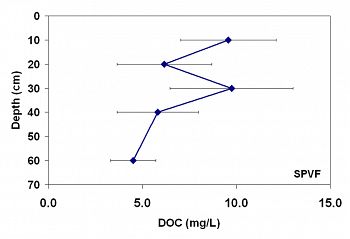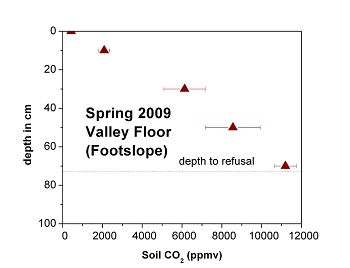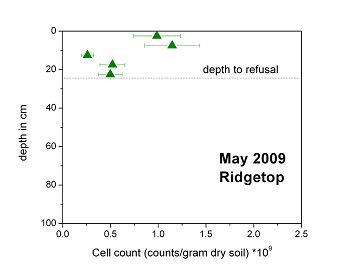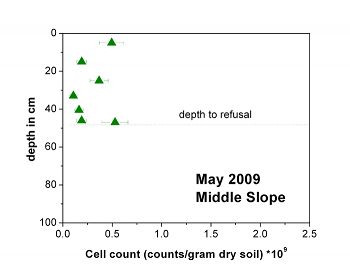Biogeochemistry Research Group
Shales, covering 25% of land surface, are an important lithology in linking the CO2 drawdown and continental silicate weathering on the global scale. We are investigating the distribution of total soil carbon, soil CO2 concentrations, dissolved organic carbon (DOC), and soil microorganisms along hillslopes and with soil depth at the Shale Hills Critical Zone Observatory.
Image: Nick Kaiser's summer REU project focused on the measurement of soil respiration in the Shale Hills catchment
This group is tagged with:
-
Soil Biogeochemistry: We are investigating the distribution of total soil carbon, soil CO2 concentrations, dissolved organic carbon (DOC), and soil microorganisms along hillslopes and with soil depth at the Shale Hills Critical Zone Observatory. These measurements will help us predict how soil microorganisms contribute to the weathering engine, and how soil development affects soil carbon storage and transport in this watershed. Jason Kaye (Department of Crop and Soil Sciences) and Susan Brantley (Geosciences) are interested in soil respiration rates at the Shale Hills Critical Zone Observatory. Soil respiration is the release of CO2 from plant roots and soil heterotrophic organisms to the atmosphere. Kaye’s group is working to quantify how water movement, water storage, and soil texture affect soil-atmosphere exchange rates of CO2. The flux of CO2 from soil is a critical component of the global carbon cycle, yet factors affecting this flux remain unclear.
Work by Danielle Andrews (advised by Henry Lin of Crop and Soil Sciences) examines how soil and landscape characteristics affect the movement of dissolved organic carbon (DOC) within the Shale Hills watershed. These studies indicate that DOC concentrations are correlated with topographic position. For instance, soil pore fluids in swale sites have elevated DOC relative to planar hillslope sites. Swales contain deeper soils than the planar hillslopes and are regions of convergent water flow that may facilitate organic matter collection and breakdown. Additionally, DOC concentrations were found to vary within the soil profile. For example, DOC increases above restrictive soil interfaces such as the clay-rich Bt horizon (Figure 1). Graduate student Tiffany Yesavage (advised by Susan Brantley of Geosciences) is investigating how variations in DOC and total carbon concentrations in turn may affect the distribution of different groups of microorganisms at different depths and topographic positions (Figure 2).Figure 1. Concenctrations of dissolved organic carbon (DOC) in a valley floor soil profile consistently show patterns of variation with depth. DOC levels tend to be elevated around 30cm, which likely corresponds to the interface between the Bw and Bt soil horizons.
The ultimate goal of this work is to understand how environmental parameters such as rates of regolith formation can be used to explain the distribution of CO2 and DOC in soils throughout the catchment. By creating this interdisciplinary team consisting of members from Crop and Soil Sciences and Geosciences, we hope to provide a theoretical basis for predicting soil carbon dynamics in shale-derived watersheds around the world.
Contacts: Jason Kaye (PI) and Susan Brantley (PI)
Figure 1. Concenctrations of dissolved organic carbon (DOC) in a valley floor soil profile consistently show patterns of variation with depth. DOC levels tend to be elevated around 30cm, which likely corresponds to the interface between the Bw and Bt soil horizons.
Figure 2a. Soil CO2 concentrations for a ridgetop landscape position.
Figure 2b. Soil CO2 concentrations for a midslope landscape position.
Figure 2c. Soil CO2 concentrations for a footslope landscape position.
Figure 2d. Total cell counts from a ridgetop landscape position.
Figure 2e. Total cell counts from a midslope landscape position.
Figure 2e. Total cell counts from a footslope landscape position.
-
Contacts
-
National, Eel, Luquillo, Shale Hills, INVESTIGATOR, COLLABORATOR
-
Shale Hills, INVESTIGATOR
9 People
.(JavaScript must be enabled to view this email address)
Penn State
Aqueous Geochemistry, Geochemical Kinetics, Microbial Biogeochemistry
Cross-CZO GRAD STUDENT
PhD Student (Shale Hills CZO), MS student alumna (Calhoun CZO)
.(JavaScript must be enabled to view this email address)
Biogeochemistry
.(JavaScript must be enabled to view this email address)
Ecosystems and environmental change
.(JavaScript must be enabled to view this email address)
Vegetation dynamics; global change ecology; interactions among vegetation, climate/human land use
.(JavaScript must be enabled to view this email address)
Aqueous geochemistry
INVESTIGATOR
.(JavaScript must be enabled to view this email address)
multiphase flow and transport, environmental engineering, and geochemistry
INVESTIGATOR, COLLABORATOR
.(JavaScript must be enabled to view this email address)
low-temperature (bio)geochemistry, geochemistry, hydrogeology, isotope geology
GRAD STUDENT
.(JavaScript must be enabled to view this email address)
Ecology
INVESTIGATOR, Visiting/Affiliate, COLLABORATOR
.(JavaScript must be enabled to view this email address)
Isotope geochemistry
Alumni-Former
GRAD STUDENT
Hydro-thermo-chemical modelling
INVESTIGATOR, COLLABORATOR
.(JavaScript must be enabled to view this email address)
Hydrology and Geochemistry
GRAD STUDENT
.(JavaScript must be enabled to view this email address)
Plant-soil-bedrock interactions and nutrient availability
COLLABORATOR, GRAD STUDENT
.(JavaScript must be enabled to view this email address)
Geochemistry
GRAD STUDENT
.(JavaScript must be enabled to view this email address)
Soil Science and Biogeochemistry
-
-
Featured Publications
2011
Hot Spots and Hot Moments of Dissolved Organic Carbon Export and Soil Organic Carbon Storage in the Shale Hills Critical Zone Observatory . Andrews, D.M., H. Lin, Q. Zhu, L. Jin, S.L. Brantley. (2011): Vadose Zone Journal 10:943-954
2011
Movement of manganese contamination through the Critical Zone . Herndon, E. M., Brantley S. L. (2011): Applied Geochemistry 26:S40–S43,
-
Photos
Biogeochemistry - images
Explore Further

























